Tagged: strike

Perfect Grade Aile Strike Gundam Painted Build, Final Review
Those of you who follow this blog regularly should probably both know that I will be repeating some things here that I already talked about in the WIP updates and on Youtube – the only thing that’s new is the Aile Striker and a few more accessories. So you might want to scroll down to that part, although I do have a few new pics along the way.

My usual philosophy is always to try something new on every build, but with this one I took a slightly different approach. For a number of reasons, among them the fact that it’s a frickin’ PG and complicated enough as it is, I decided to treat this more as a milestone build and just throw every technique I’ve learned over the past year and a half at it. Things I know will work, basically. That’s why, for example, the color scheme is the same as on the Master Grade Mk-II – that’s my personal version of the Gundam colors, I know I like the way it looks, and so I used it again here.
I still ended up doing a few somewhat new things – that just seems to happen kind of inevitably. I’ve never actually done a gunkwash over pre-shading, or on any painted Gunpla, for example, or this much detail painting on the inner frame, or this much masking. But that’s just more of familiar things or combinations of techniques that I’d used before.
The general process here was basically the way I approached the RX 78-2. I painted and weathered the armor first, then took it all off again for topcoating, and dismantled and painted the inner frame.
After priming, I pre-shaded the white and off-white armor pieces with light grey and the red ones with black. The blue pieces were primed black, painted flat and then highlighted with my own custom mix of blue and green that I’ve used before on the Mk-II.
The big news here is that I really think this one is the build where I finally got my preshading dialed in. As you’d expect with anything airbrush-related, most of it had to do with mixing ratios. I figured out that I needed to thin the shading paint much more than I usually would so that it would spray evenly at low pressures and not give me specks all over the place, and then just be, y’know, really really careful not to produce any spidering because the paint was so thin. If you’ve been following this blog, you should know that preshading has been sort of an ongoing struggle for me – I’ve always loved that heavily preshaded Japanese style of painting, but I could just never quite get it right, so getting the look I wanted, and on a complex kit like this, is really satisfying.
Anyway, after the pre-shading, I sprayed my usual custom mix of Tamiya’s red and red brown over the red parts for that muted look, white for the white parts and a mix of white with a few drops of light grey for the off-white.
The next step was a gloss coat and then waterslides. Because Bandai refuses to make waterslides for their PGs, I had to resort to third party again, but I’m very happy to report that the ones I used here, from DL, turned out to be almost as good as Bandai’s. The print quality is excellent, they’re pre-cut with razor-sharp precision, and they’re very easy to work with. Although that’s partly due to their one downside, which is that the carrier film is just a teensy bit too thick for my tastes. That means it’s easier to move the decals around and not have them crumple up and fold in on themselves, but they just don’t look quite as painted on as Bandai’s.
After decals came another gloss coat and then a gunk wash with Abteilung 502’s Starship Filth. Here I ran into my first real problem with this build. Like on the Storm Sworder before, the surface quality of the gloss coat wasn’t quite as slick as it should have been on all the parts, and I was more concerned with not filling up the panel lines, so I didn’t fix it. Turns out that on light colors, the difference in how the oil paint tints the color when you wipe it off becomes more pronounced, and it also became an issue that the shaded and plain areas had different surface qualities that still poked through the topcoat. I was able to fix this more or less by using a little oil paint thinner on those pieces where the paint wouldn’t wipe off as much as I wanted to, so I ended up with reasonably uniform shades of white and off-white, but it did affect how much of the Starship Filth remained in the panel lines and crevices, and so now the panel lines aren’t as uniform as I would’ve liked them to be. Not a huge issue because gunk washed panel lines definitely read more like a weathering effect and thus shouldn’t be entirely uniform anyway, but definitely a lesson learned for future builds.
After the gunk wash came another top coat, and then I could finally slap the armor back on the still unpainted inner frame to see what it all looked like.
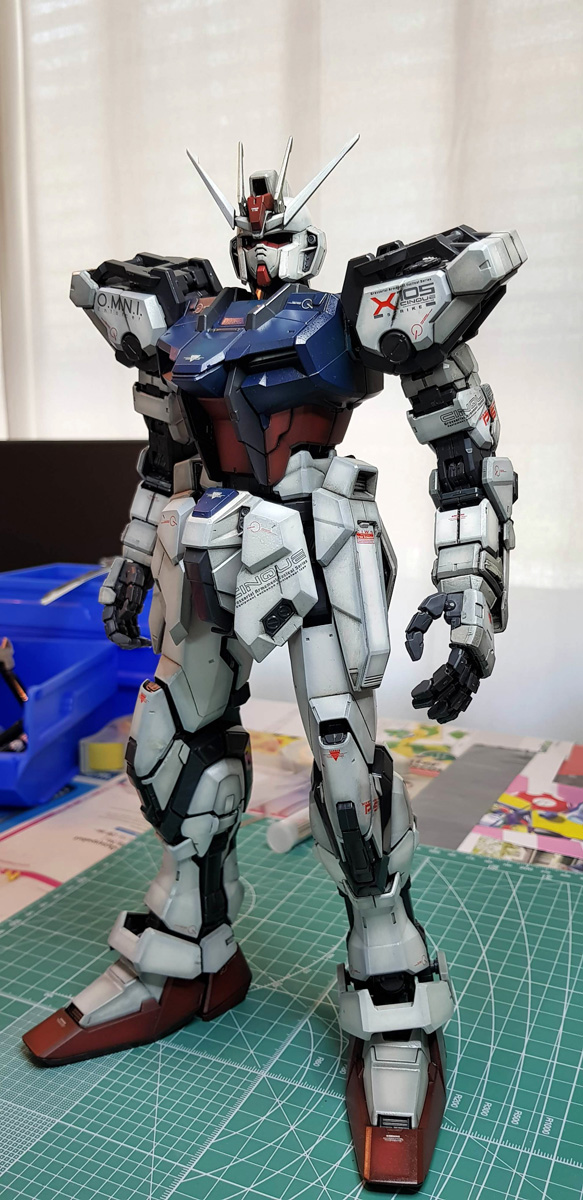
And it’s a good thing I did because seeing it all put together like this, you really notice that between the preshading and the gunk wash, it already looks very faded and worn, and you could really leave it like that. I had already resolved at the start of this build that I wasn’t going to weather the kit as heavily as I usually do, but this test assembly made me restrain myself even more. In fact, I still like this look so much that I’m probably going to paint another kit like this soon and not do any further weathering.
So I did the usual, just less of it. First I drybrushed all the edges with the base colors for highlights, and then I went back to chipping with a detail brush instead of drybrushing all over the place. I’d previously done this successfully on the Gun Sniper and, let’s say, less successfully on the RX 78-2, but it was clear that the drybrushed approach was going to be too much here. I only drybrushed scratches in a few places like on the feet or around the shoulder joints where I thought more wear and tear would occur, the rest is all done with a tiny brush and lots of patience. I must say I’m pretty pleased with how it came out, although of course it’s also a bit easier on a larger scale kit.
The colors were the usual – Tamiya chrome silver for the red and blue, gunmetal for the white and a few dabs of Gunze’s rust here and there. Then I drybrushed the customary heat streaks around all the vents and the head vulcans and added just a small handful of rust streaks with Vallejo’s Dark Rust and diluted india ink, basically to some of the bigger chips that I had previously added a dot of rust to as well. When I decided to add a bit of Vallejo’s Engine Grease to have grime streaking out of the knee joints, I started to run into trouble (the streaks on the left shin are much more than I wanted), so I took that as my sign to stop. Well, actually, I also sponged some Tamiya Brown/Light Grey on the feet and then stopped. I did mention I repeated almost every single technique I know here, right?
Here are a few pictures of weathering details from the finished build. Obviously this was after I’d also painted the inner frame. With just the armor painted, it looked like this.
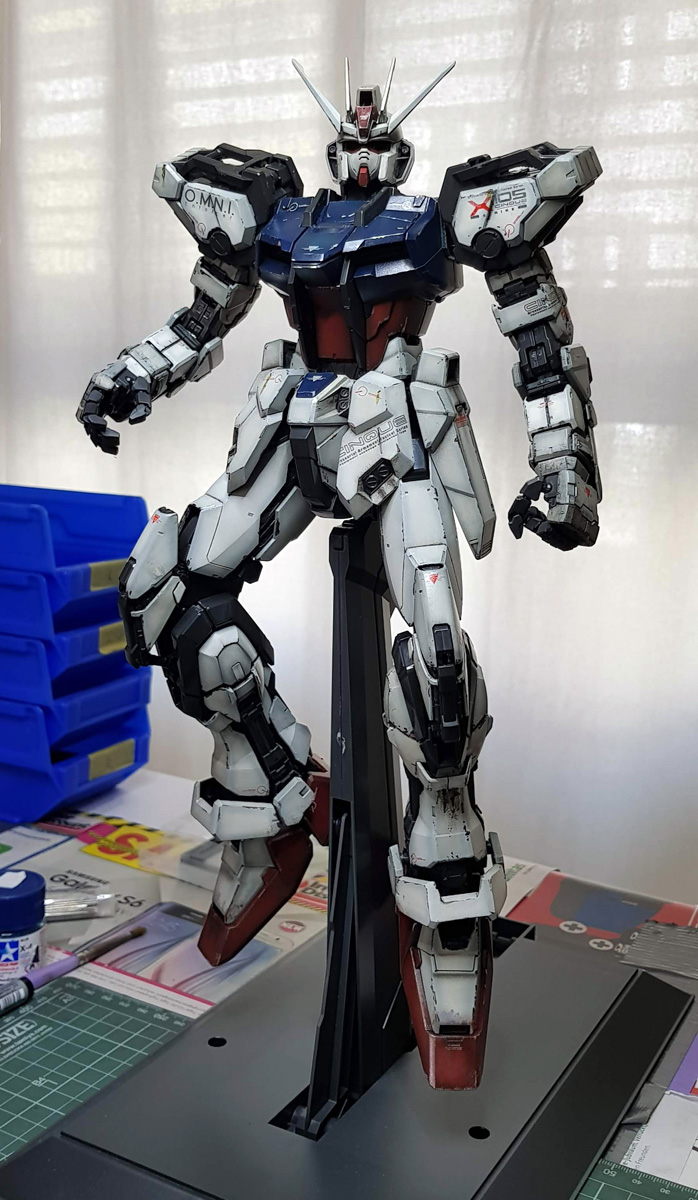
And then I had to take it all apart for topcoating and to finally paint that inner frame. First I snapped a series of reference pictures, though, so I would remember which parts of the inner frame would be visible; I did want to do a fair bit of detail painting, but I had no intention of doing a full paintjob on the inner frame just so I could take a few pictures and then hide it under the armor forever. It’s awesome when other people do that, but it really just bugs me when I spend a lot of time on stuff that I then can’t display, even if I’m almost the only one who ever looks at my shelves anyway.
The general approach with the inner frame was first to settle on a relatively simple color scheme – gunmetal over black primer as the base color, then chrome silver, gold leaf and red for details. There are a tiny handful of parts that I base painted in silver or gold, but almost everything was painted gunmetal. Then I made sure I painted similar looking details in similar colors; gold for pistons and round screw-like parts, silver for raised panels, and red for smaller tubing and a few recessed squares that I decided might be lights. Finally, I drybrushed everything silver on the gunmetal and white on the gold and silver, plus rust on everything.
As you can see, the end result was that it gives a nice sense of depth and detail to the inner frame where it shows through the armor plates, and a few cool effects with mechanical detail being revealed as the joints are moved, especially in the knees. The legs in general I’d say are not only my favorite part of this kit engineering wise, but also where I probably did the best job with the details, but it was also easier because there’s so much cool stuff to work with.
Another new trick I learned here was to paint the frame in sections; I did the torso first and then one limb at a time. This allowed me to keep one limb completely assembled as I worked on the other one, so it was much easier to see what goes where and how it should be painted. I don’t know if I’m going to repeat this approach on the next MG I build, but for something this complicated, it really helped.
And then I could finally slap the armor back on and put it all together.
And that brings me to what you all know it brings me to – accessories.
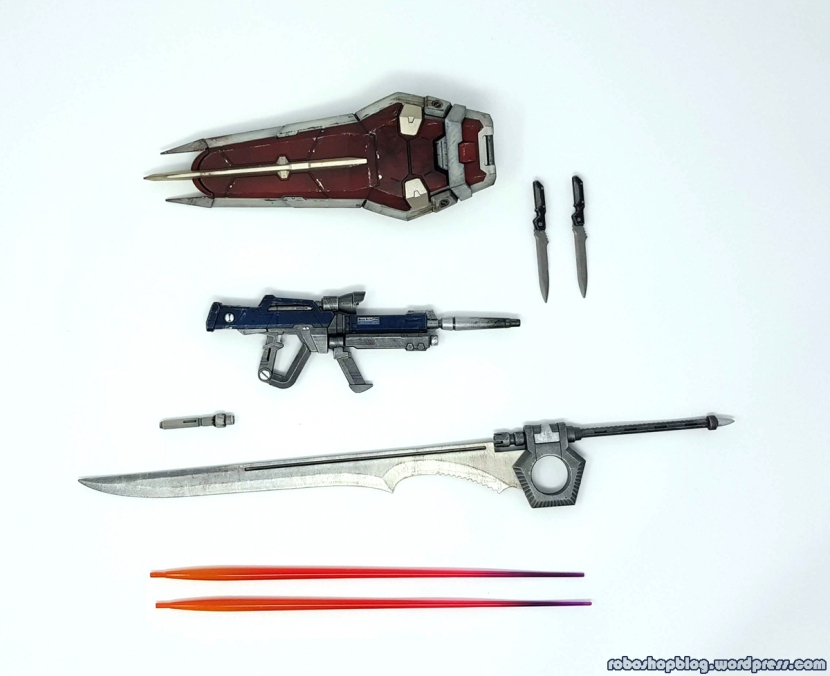
With the base PG Strike kit, you get the beam rifle, the shield, the Grand Slam sword and the Armor *snicker* Schneiders. The beam sabers are included with the Skygrasper/Aile Striker kit, so I tossed them in this picture here.
I painted the inside of the rifle gunmetal with a few silver details here and there, especially the barrel, which needed to be masked. The outer casing is the same blue over black with highlights, drybrushing and a gunk wash as on the suit, just with a lot more drybrushing because I thought the weapons would have more wear and tear. The camera is clear red on the outside and silver on the inside, and I did the usual soot/heat streaking around the muzzle. I’m thinking on a future build I’ll try actual heat discoloration, but you know what the theme for this one was.
The shield is the same red and white with pre-shading as on the suit, titanium gold for the yellow parts and gunmetal with a few silver details for all the mechanical stuff, including a few details and the handle at the top that I painted at the end, as usual, to keep them shiny. As you can see, the inside of the shield is gunkwashed with a lot less cleanup than I usually do to give it this dirty appearance. There’s also pre-shading under there, but you can barely see it anymore.
The mechanisms for the moving handle and the small blast shield were a bit of a problem. I left the clip the handle attaches to unpainted, but it’s so tight now that I don’t really want to move it anymore. And the blast shield was hard to move before the shield was painted, so I knew I’d have to sand it down a good bit, but even after doing that and a lot of test fitting before I assembled everything, it’s still hard to move.
Oh yeah, and the clear part in the… I dunno, the peephole, has the same light grey sponged-on dirt I usually do on canopies.
Since I don’t particularly care for the Grand Slam sword and the Armor *snicker* Schneiders, I kind of broke with the theme for this build and used them as an opportunity to experiment a little.
The tennis sword, of course, comes with a chrome coated blade, and once I had painted the handle and put it back together, it became 100% clear that it looked unacceptable. Bandai’s mekki plating is nice and all, but next to properly painted parts, it just still looks too toylike.
That left me with the problem of having to strip the plating off the part, which I’d never done before. After two failed attempts with bleach and a mild degreaser, I bought a bottle of concentrated car degreaser from the local hardware store, soaked the blade in the stuff for a few hours and poof, gone was the chrome coating with zero damage to the part. I’m really glad to finally have found a product that does this for me, and I’m thinking I’ll use it to strip paint in the future as well.
Then I primed the blade with Vallejo’s gloss black primer that I’d discovered while I was working on this build and thus hadn’t used elsewhere.
And then I decided to just try some silly stuff and see what it’d look like. I also bought a few of Vallejo’s Metal Color paints to experiment with, but I decided to stick with the Tamiyas so it wouldn’t clash too much with the other metallic stuff on the kit (which is dumb and I’m dumb for doing this dumb thing, I’m just explaining my reasoning.) But instead of just painting it straight chrome silver, which seems like the obvious thing to do, I first painted the whole blade gunmetal, then added a gradient of gold leaf from the hilt, then a thin coat of chrome silver on top. This ended up doing exactly what I’d hoped it would, which was the illusion of an iridescent surface; you can’t quite tell what color it is because the lighter areas with the gold underneath seem to be that way because they’re catching the light, but they’re actually not.
But of course that looked too pristine, so I drybrushed all over the blade with silver, titanium gold, gunmetal, white and rust to make it look all beat up. It kind of ended up taking away the iridescent effect, and now it looks more like it’s so worn that you can’t tell what color it is anymore, which is also fine.
In fact, I now like this sword so much that it kind of sucks that I can’t use it.
The armor tailors, as I’ve complained about before, are a problem because they come pre-assembled on the same sprue as the hands, which makes it unnecessarily hard to paint them. When you really think about it, though, even if the blades were separate pieces, the first time you fold them, you’d scratch half the paint off of them anyway, so it really doesn’t matter.
Now I could’ve masked the handles and airbrushed the blades, but I had just picked up some Citadel paints and decided to give those a try instead. After all, the worst thing that could happen was that I’d ruin an accessory that I wasn’t going to use anyway. The only reason I painted these in the first place was because the idea of not having painted everything that came with the kit bugged me.
So I used Lead Belcher, which seems to be sort of the go-to silver color in the Citadel range, on the blades and the detail on the handles. I have to say this stuff is almost as good as I hoped it would be. It still takes about three coats to get a good even finish and you still have to be careful to get the thinning ratio just right, but it’s a hell of a lot easier to do than with Tamiya acrylics, and the end result looks about as close to airbrushed as any hand painted surface is ever going to look.
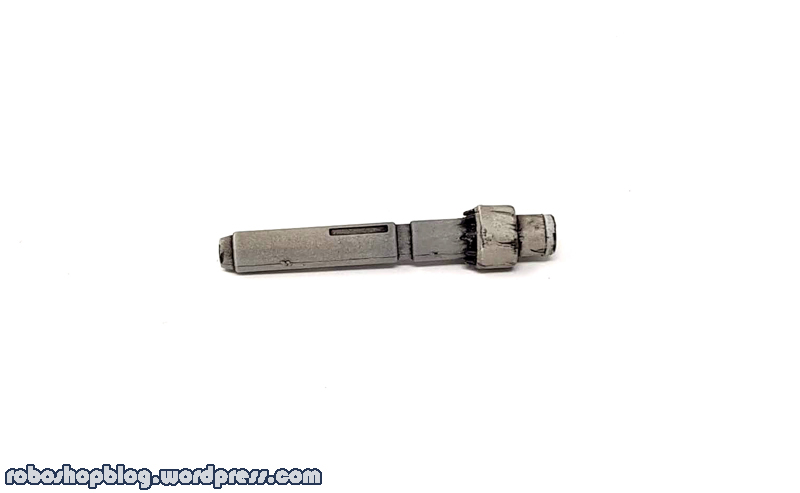
Not much to say about the beam saber handles. The part that I guess you’d call the cross-guard is nicely detailed, so I painted those parts gunmetal, and I did the usual heat streaks (because beam saber blades cause heat streaking because science and no, I’m not going to stop running this joke into the ground), and of course they’re pre-shaded, gunkwashed and chipped.
You might also notice in the picture that the paint is basically stripped towards where the effect part plugs in – that’s because the slots they fit into on the Aile Striker are too tight. I may go back and remedy that with modding, given that I have a second complete Aile Striker kit, but for now, um, yeah.
As for the effect parts, I had that same reaction to them as I did with the Grand Slam blade where it suddenly bugged me how toylike they looked in unpainted form, so…
The original idea was to paint them clear yellow at the bottom, but that didn’t work at all. Lighter clear paint on darker clear parts does basically nothing. So I added a gradient of lemon yellow instead and kept it very light so as to not go fully opaque, and that worked very well.
I then painted the tips blue – the idea was to have a gradient from a warm to a cool color here, basically, and while that makes sense in theory, I kind of feel like the purple that resulted from painting the tips makes the parts look a bit too much like candy. I’ll probably do the yellow at the bottom again, but no more blue on the tip.
And that’s our opportunity for another pose gallery. I think the only thing I have to say here is that if you don’t want to shell out the extra bucks for the Aile Striker kit, you’ll still get a heck of a PG with the Strike.
But as far as this build’s concerned, saying that is just my segue into talking about the Aile Striker.
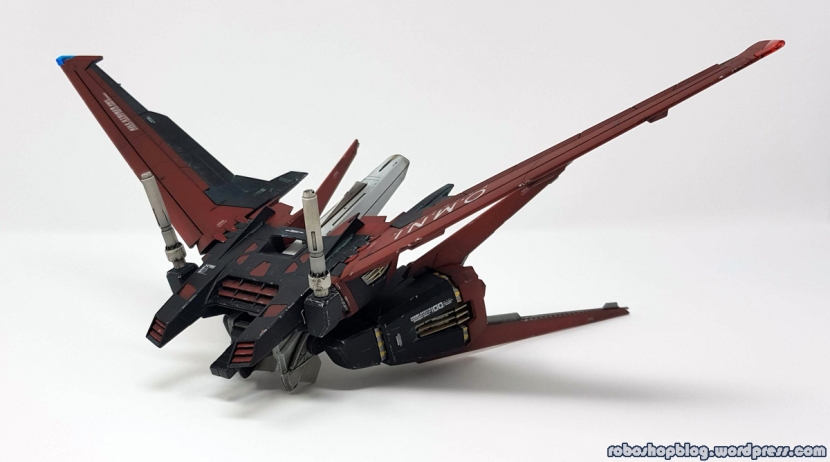
Now the first thing I needed to figure out was something I had basically been putting off since I originally snap built the suit itself. Back then, I promised myself that I would snap it together before I started painting anything to make sure I had a clear plan for the color scheme. Well, I didn’t. And what I’d never figured out was what to do with these dark grey parts that are molded in more or less in the same color as the inner frame of the suit.
One thing I considered was gunmetal, but that would have raised a whole host of problems with glossy and matte surfaces right next to one another, and I also thought it didn’t really make sense for the outer hull here to be the same color as the inner frame elsewhere. So I ultimately settled on black, despite the fact that I hadn’t used black anywhere else on the kit.

Now that in itself was fine, but now I had to figure out how to weather this stuff. What I’d normally do with black is just drybrush silver all over it, but that results in a much more heavily weathered look than what I wanted here. So after some experimenting on spoons, I decided to do a gunkwash instead, with Abteilung 502’s Ghost Grey. That’s how I got these bluish-grey panel lines and the accumulated dirt in the recesses that you see here.
That was followed by edge highlights with Tamiya light grey and some chipping.
Now as you can see here, I also did some masking to add color separation. I have to say if there’s one disappointment I have with these two kits, it’s the lack of complexity in the Aile Striker (and the Skygrasper, for that matter.) Its proportions are about as perfect as they possibly could be, but just out of the box the lack of color separation makes it look really bland and toy-like. So I just painted some of the detail in the same red as everywhere else.
The rest was fairly straightforward and just followed the color scheme and weathering steps of the suit itself, really. I also added a few extra decals to break things up, and of course the position lights on the wings are painted with clear paints. No silver on the inside because I figured it’d just scrape off when I attach the parts.
And with that, the build was finally complete, at least until I decide to make the base more interesting.
I really feel like this is my best build yet by quite a large margin. There are mistakes and things I’d do differently if I could do it again, but the overall result is about as close to what I wanted as it could have been. I’m especially happy about the fact that I pulled off the more restrained approach to weathering that I wanted to take here, and seeing the result of that has definitely taught me a lot about how important it is to apply weathering in moderation and how the different stages complement one another. And as for the “milestone” approach, it’s probably not that surprising that I still ended up having to try new things.

Now as I’m writing this, I’ve already got a list of new techniques in my head that I want to try, and old ones that I want to go back to and give another whirl, so while I may have been a bit worried that throwing everything in my toolbox at one build would end up make me feel burnt out, it’s actually done the opposite. I dunno, guys, there’s just nothing negative about this build, it’s been an absolute blast working on this, and it’s made me a better modeler and hungry for more. I hope you all at least get a kick out of looking at the pictures.
Real Grade Aile Strike Gundam
Yeah, I know, where the hell have I been. Like I said last month, I have actually been building lots of things, I just really haven’t had time to take pictures. Winter means it’s usually dark when I’m home and since I rely on daylight for my photoshoots, it’s been hard to find time to snap good photos of my build. I may have to get a photo booth or just live with night pictures for the next few months.
Anyway, while I was waiting for the Skygrasper to go with my PG Strike, I decided I’d build this kit to tide me over. I was also in the middle of painting an MG Banshee Norn, but since I was kind of going through a slump with that one, I figured maybe actually finishing a kit would, I dunno, help me regain my Gunpla mojo.
Also, Real Grades are like crack, and I can’t stop buying them.

The RG comes with the Aile Striker unit, obviously, unlike its PG ancestor, but the parts count still isn’t that crazy. It’s only the 3rd kit in the RG line and still relatively simple.
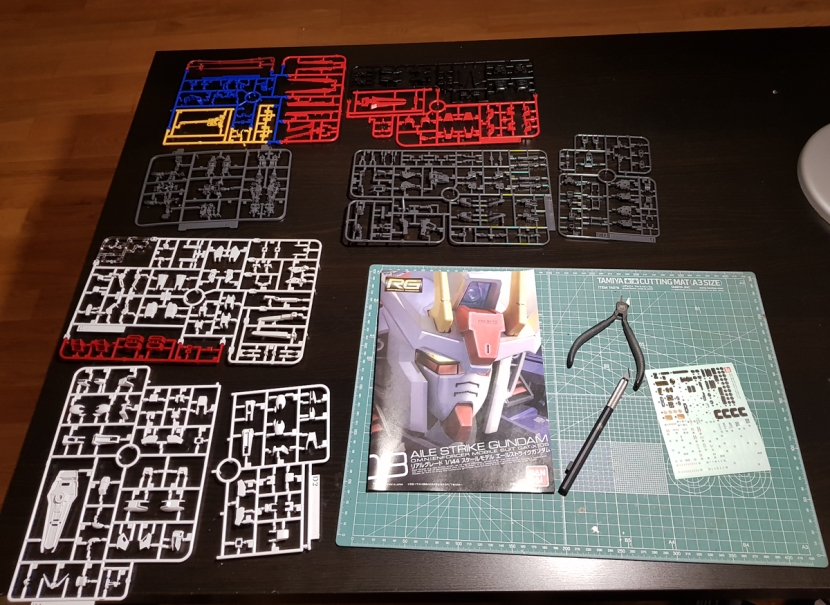
Note also the small sticker sheet. There’s an obnoxious amount of foil stickers, but only 74 regular markings, not counting multiples. Certainly far less than for the RX 78-2 and the Zaku that immediately preceded this kit.
Partially motivated by this, I decided to try something new and panel line this one. I never did this on Real Grades before – many of them look cluttered as it is, especially once you get the stickers on, and I always thought it was weird to have so many “real” panel lines because of all the parts separation on the armor and combine that with panel lines that are painted on. With hindsight, I’m glad I did it, and at least the Freedom probably could’ve used it too.
The way I decided to go about this was, I panel lined everything on the sprues with liquid ink Gundam markers – black for the blue and the dark red parts, grey for everything else. This seemed by far the fastest way to get the job done, and when you’re using these markers on bare plastic, it’s actually best to let them dry for a while anyway. For some reason, when they’re dry, they wipe off the surfaces more easily than when they’re still wet, and they stick to the panel lines like glue. So I just did basically a pin wash on everything first, then cut the parts loose and wiped off the excess during assembly. By the time I got around to each individual part, it had had enough time to dry to make cleanup really easy.
Once I’d cut all the parts off the sprues, I ended up with this.
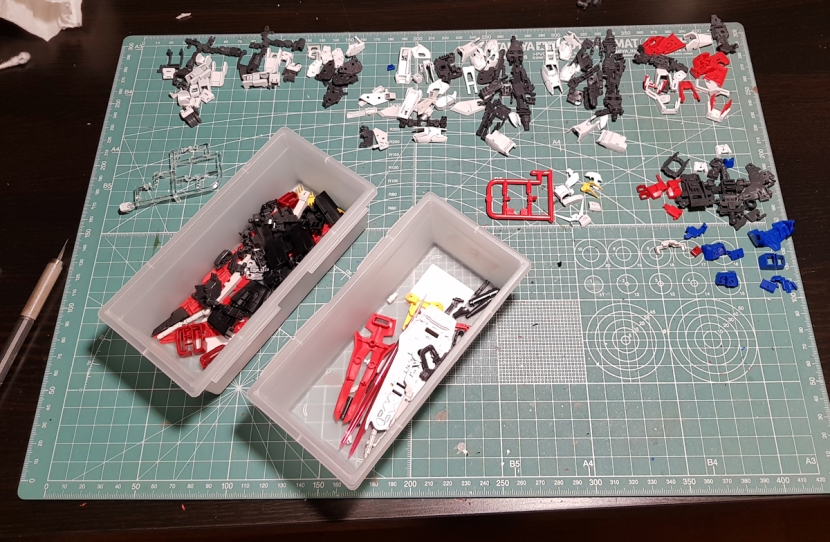
The trays contain the parts for the Aile Striker and the weapons, the rest is sorted by the steps in the instructions. It took about four hours to get here, and those four hours weren’t particularly enjoyable, but then again, they were followed by 90 minutes of uninterrupted assembly, so that part was really fun, and I’ll probably build all my RGs like this from now on.
Now stop me if you’ve heard this one before, but the build starts with the feet.
As you can see, they look nice (note the color separation on the soles) and consist of quite a few parts. As usual, though, articulation becomes virtually nonexistent once you get the armor on. Y’know, it’s an RG, so… yeah. That’s what happens.
The legs are one of my favorite things about any version of the Strike, so I was really looking forward to the next step, and it didn’t disappoint.
There’s not as much going on here as on the PG – the way the knee armor moves is far more simple, and the side pistons aren’t connected to the ankles. But the legs still look really, really nice with all the parts separation and the inner frame showing through the gaps. Right about here I also realized that panel lining this kit was a good idea as there’s tons of small detail on every armor part that pops nicely once it’s lined and adds to the mechanical feel of the legs.
The skirts are also relatively involved – each of them consists of two parts, and the side skirts have three because of the opening hatch for the Armor *snicker* Schneiders.
And I swear, you guys, this was the first build I documented with my new phone, and it did that thing where only the feet are in focus again. Both phones are Samsung. Do Koreans have a foot fetish? Sigh.
The shoulders are a disappointment, I’m afraid.
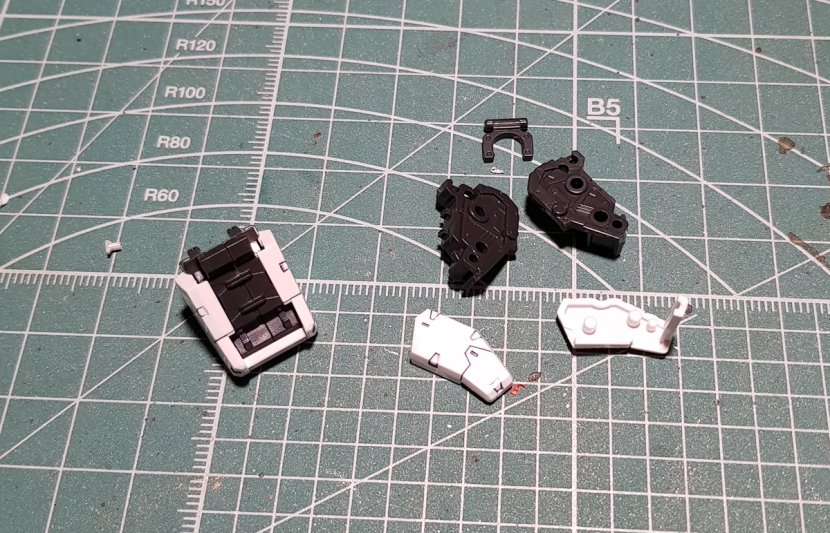
It’s ok that they’re this simple because they don’t really have to do anything, but they just look blocky and ugly. In fairness, there’s another part for each of them, but they don’t tell you to do this until you plug the arms into the torso – it’s the contraption on top that folds out where the add-on parts attach that come with the Skygrasper.
The arms aren’t all that hot either. Of course this is kind of inherent to the design of the Strike, but to me they look like a bunch of dice stacked on top of each other. That straight line down the front really is a bit much.
Also, the closed fists on the B sprue are the usual cat’s paw hands that nobody in their right mind would want to use, and since there aren’t any other options, you’re stuck with the articulated hands. And no, I won’t stop saying that those are ugly. Because they’re ugly.
The torso’s next, and I’m happy to report that it’s very detailed and much less frustrating to build than the PG’s torso.
I also still think the Aile Strike looks like a Camaro that thinks it’s a robot that transforms into a plane. Just, y’know, for the record.
Other than the opening cockpit hatch revealing the usual empty pilot seat, the torso doesn’t do anything, but it doesn’t need to – it’s just where you plug in the Aile Striker, after all.
The head is next, and, well, what can I say – it’s a Real Grade head, so you know what to expect.
Everything’s molded in the correct colors, and the detail is great. Like on the Freedom, though, the camera piece is inexplicably molded in clear plastic instead of the blue shown on the box, so you’ll have to paint it if you want accuracy. I skipped that this time because I’m still miffed about how dark it came out looking on the Freedom.
I also have to say that looking at the kit in real life, I don’t really think the head’s too big. That’s a common complaint about this one, and looking at pictures I always kind of agreed, but now that I’m looking at it on my shelf, it’s really fine.
Anyway, since I have the PG sans Skygrasper, of course the Aile Striker was the main attraction for me. It was getting late at this point, but no way was I going to stop without getting to see the suit with the wings on.
Speaking of the wings, for a pair of what’s basically straight airplane wings, they do consist of a lot of parts, which of course means they look really nice.
Up next are the boosters, which are also very detailed. They also come with a bunch of foil stickers that go behind those red grills, if you’re into that sort of thing. I didn’t use them.
And once the boosters are done, you plug it all together and your Aile Striker pack is done.
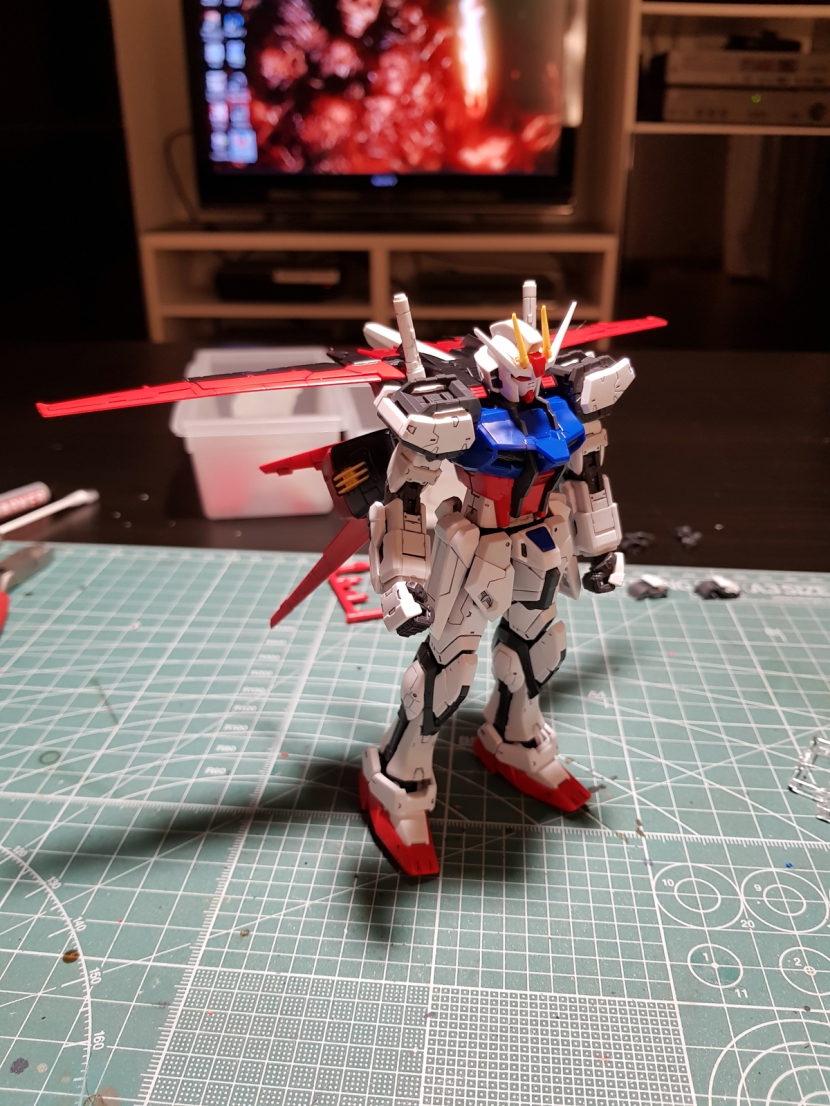
Now here’s the real shocker. You see that? No, not Gravelord Nito in the background. The kit is standing up straight. Only leaning forward a little. With that giant backpack on. I don’t know how that’s physically possible, but I saw ‘er with my own eyes, mister.
Now, accessories. The instructions actually tell you to build these before the Aile Striker, but I skipped ahead and then built the weapons the next day.
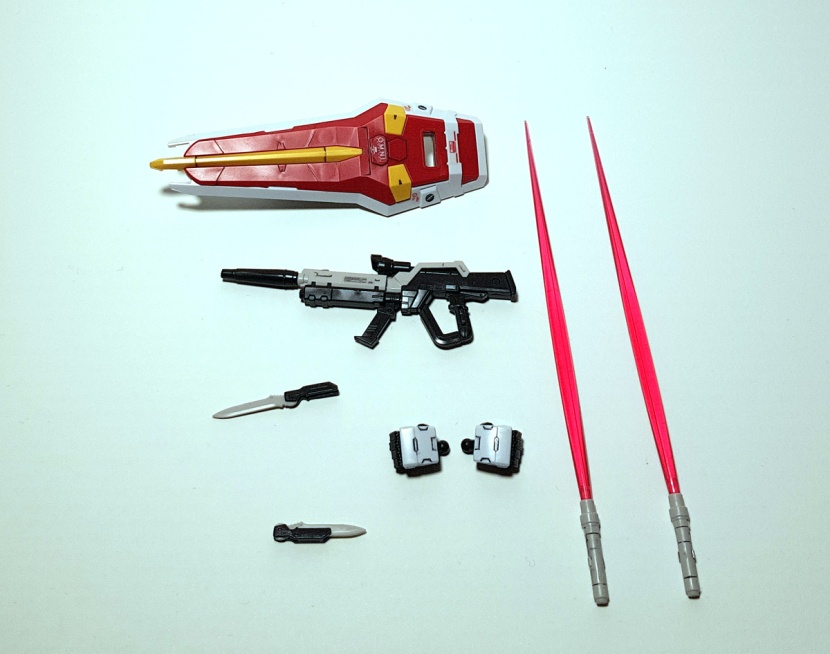
It’s not much – you get two beam saber effect parts, closed fist and articulated hands, the beam rifle, the Armor-Schneiders (no, I didn’t type that without giggling), the shield and the usual action base connector. It all looks very nice, but it’s not perfect.
The camera piece for the gun is also molded in clear plastic, and attaching said gun to the hand is a massive pain because the tab that folds out is so loose that you end up folding it back in instead of getting it into the palm about a dozen times before it works. There’s a trigger finger hand that comes with the Skygrasper set, but that doesn’t work either.
I also don’t like how the beam saber handles that go on the back are dummies and you have to store the real ones that actually go in the hands separately, especially because you only get two of the top pieces that the blade effect part plugs into, so you have to swap them out if you want to pose the kit with the sabers. Just seems like a totally unnecessary omission to me. And finally, while the Armor-Schneiders are actually better than their PG counterparts (they’re two separate pieces instead of the pre-molded stupidity on the PG), the hands can’t hold them for shit, which is why there are no pictures here with them.
Poseability is ok, but those side skirts do get in the way of a lot of leg movement, I’m afraid. Somehow, though, probably because of the backpack, almost every pose you do with this kit looks really cool.
As you can see, I did end up using a good number of those foil stickers for the wings, and for some unfathomable reason I actually quite like them. I don’t know what’s wrong with me.
Anyway, I’ll have another blog coming about the RG Strike someday – I also bought the Skygrasper with all the extra weapons, but there’s so much in there that it really does warrant a separate entry.
Meanwhile, do I recommend this kit? Absolutely. Other than the shitty hands, it’s very solid without sacrificing poseability – one of the least fragile RGs that I’ve built for sure. Of course if you’ve never liked the Strike or generally refuse to buy SEED kits, this one won’t change your mind, but I happen to be a fan of this particular design, and the RG is a very nice representation. In fact, I have a second one that I plan to detail paint and matte coat.
Perfect Grade Strike Gundam Build Review
I was originally going to hold off on posting anything about this kit before I finish it, but I did want to do a full build review, and I ended up taking so many pictures that I figure it’s probably better to break this up into two or more blog posts. We’ll start with this build review, and then I’ll probably do a more in-depth review of the OOB kit and ultimately a discussion of my paintjob, whenever that’s finished.
Note: as usual, that plan lasted about as long as it took for it to come in contact with the real world. I finally finished painting this kit almost a year later, and you can check it out here.
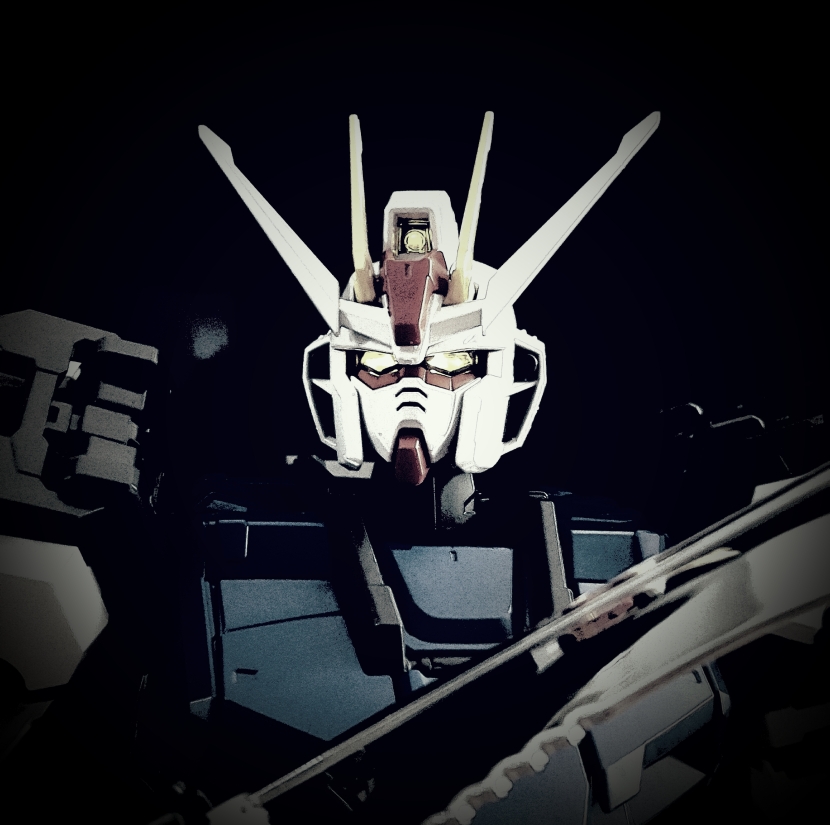
Anyway, the PG Strike came out in 2004, so it’s no spring chicken anymore, but after having snapped it together, I have to say it holds up fine. Since it’s over a decade old, it seems to predate most Gunpla blogs and Youtube channels out there, and there aren’t nearly as many reviews as of more recent kits. All the more reason for me to give you a detailed look at it, of course.
The box isn’t much bigger than the MG Sazabi Ver. Ka’s, and with the Unicorn being the only other PG under my belt, I was a bit surprised by the low parts count. It’s been a while since I built the Sazabi, but the two kits are probably similar in complexity. The Strike is hardly a daunting build, it’s just big because it’s 1/60.
I won’t bore you with a detailed play-by-play of all the sprues, let’s just look at what’s interesting from today’s perspective. For one, you get three die-cast parts that go in the legs and the hip. Apparently they used these a lot more often in earlier PGs, but I don’t quite understand what they’re for. Probably to make the joints tighter, but I wonder if they don’t just destroy the polycaps in the long run.
The yellow bag contains the parts you need to assemble the LED unit because apparently there were no pre-assembled LED units in 2004, and the chrome plated sprue has the blade for the preposterously named “Grand Slam” sword and a bunch of pistons that are all over the kit, but mostly hidden under its armor.

You also get two manuals. The “construction manual” is the one with the actual building instructions. The other one has the guide for the stickers and a whole bunch of Japanese text and artwork detailing the suit’s features and (I assume) its backstory. It also has a page that seems to say that the Sword Striker and the Launcher Striker are forthcoming, but as we know by now, that never happened. The kit does have what appears to be attachment points for them on its shoulders, though.
The first thing you build is the feet. It was kind of a recurring theme for me during this build that the kit reminded me of RGs in some ways, and this was one of them. You put together the the jointed inner frame, then you add the armor to it. Note the nice color separation on the underside of the feet.
These red parts snapped together with a really violent click, though, and I’m more than a bit worried about what’s going to happen when I try to take them apart for painting. One of the ways you can tell this kit is old is the much harder plastics used and the tight parts fit in a lot of places.
Up next are the legs, which are by far the most complex and also the best part of this kit. For some reason I got it in my head that I wanted to cut all the parts off the sprues before I assembled them, and I ended up with this.
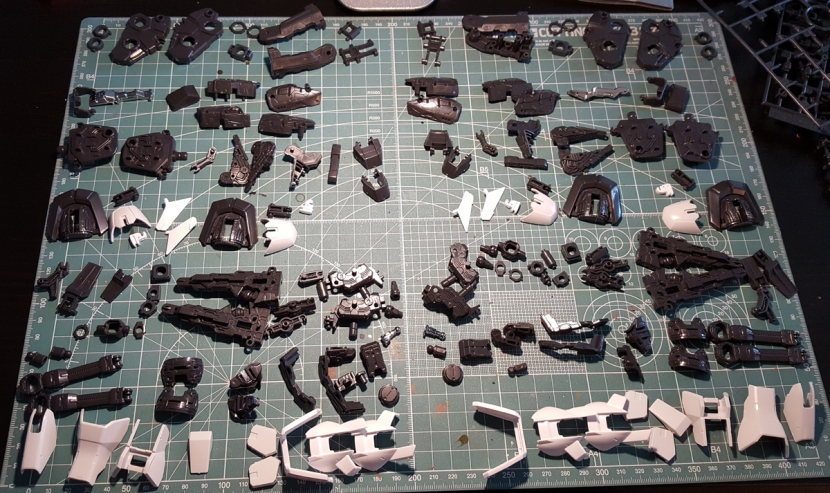
Ulp. And this isn’t even everything, of course I forgot some stuff.
The first thing you do is sandwich one of the die-cast parts in between two plastic halves for the knee. You can see the shiny metal in the middle there. Looks neat, but I don’t know how I’m going to paint this.
Next you attach the upper thigh to the knee. It contains this fairly complicated hinge mechanism that allows the armor plates to shift out of the way of the knee so that it can do a full 180 degree bend. Another way the kit seems a bit like a precursor to the RG line.
It already looks pretty cool here, but wait’ll you see it with the armor attached.
Next is the lower part of the knee assembly with a mechanism that’ll allow the knee armor to move around when it’s attached.
Note the frankly insane amount of surface detail on the inner frame. Sadly, 90% of this gets covered up by armor, and it’s also crazy shallow, making it difficult to paint. At this point, I’m not sure what I’m going to do with all this yet. The easy copout solution would be to paint it black and then drybrush silver all over it so that at least the detail will pop, but we’ll see.
This is the assembly of the shin and ankle. These two long parts that are pointing outward in the fourth picture then fold down and attach to ball joints on the ankle, which makes them move up and down when you move the ankle side to side. It’s quite striking (haha) in real life because the entire lower leg seems to be in motion when you move the ankle, but in static pictures, it kind of loses its impact. There’s also an opening flap on the back and a hydraulic piston. In fact, the shin is more complicated than the upper thigh. as it has moving parts on all four sides.
And then you plug the legs together. Up until this point, they’re actually identical. The only difference between them is the direction in which the hip joint is attached and one armor piece in the back.
Oddly enough, the hip joints are more or less cube shaped. With my spotty knowledge of Gunpla history, I find myself wondering at which point it became standard for these to be spherical. They tuck in between the armor parts rather nicely, anyway.
Here’s a look at the knee bend. Note how the knee armor first pops out, then moves backwards to become flush with the leg again at full bend. This works 100% smoothly, and it looks fantastic. You also have to love the overall patterning of the white and off-white armor with the dark inner frame showing in the gaps… like you’d expect on an RG today.
Unsurprisingly, the waist unit and the skirts are a far more simple affair than the legs. The skirts generally consist of about four parts each, including the side ones with the opening hatch to store the knives.
What’s really disappointing to me is that for some reason the vent on the side skirts is molded into the white armor and not into the grey inner frame part behind it like on the other skirts. That seems like a really weird oversight. I’ll just paint this, but it’ll be a pain – the vent is almost a centimeter deep. Sigh.
The waist unit also contains the final die-cast piece to form one of these moving hip joint mechanisms that never made much sense to me.
Up next is the torso. Spoiler alert: this was the one part of the build that I did not enjoy.
It starts out interesting enough as you build it basically from the inside out, beginning with the cockpit seat. The seat can slide forward and has a screen in front of it that folds up and down.
Once this section is done, though, there’s problems. You next build the shoulder joints, basically, which attach via these slits seen on the side above.
And while these look nice what with the four chromed pistons and they also work very well once you have them on, parts fit here is a disaster. Basically, one of them was so loose that I was wondering if it was meant to slide up and down as part of the kit’s articulation, and then I tried to put the other one on, which was so tight that I had to shave off some plastic to even get it to fit.
I kind of mixed up the next few steps. What you see here is the front cockpit hatch and then the chest armor, basically, which slides over two clear pieces (that end up being more or less invisible, like so much of the cool detail on this kit) to form part of that distinctive looking Camaro chest grill. What, I’m not the only one who thinks the Strike looks like a Camaro, right? Guys? You guys?
Uh, anyway, I don’t think this is the order you’re supposed to do it in according to the instructions, but what I did next was assemble and attach the lower half of the torso, seen here first without and then with the armor on.
This section was damn near impossible to put together, which is why I forgot to take a picture of it separately. I don’t know if I just screwed something up, but basically it consists of two halves with a polycap and a hard plastic cap wedged between them, and absolutely nothing fits. I squeezed, I cursed, I took it apart about five times to check whether I’d done something wrong, and then I just shaved off plastic until it would close up well enough to clip the white armor pieces on it.
The waist joint is still holding up fine, so I didn’t end up destroying anything, but I was pretty concerned that I would. I’m not sure if this is my fault or the kit’s, but it sucked.
The last thing that goes on is what I decided is the backpack, and then you attach the torso to the legs. The proportions are a bit exaggerated because of the camera angle here, but the Strike does have extremely long legs for its torso.
And yeah, I know that’s not a backpack, and I know there’s nothing there because it’s where the Aile Striker goes, but it amused me to think of this as the backpack because it’s a Gundam and they all have backpacks.
On to more pleasant business: the head!
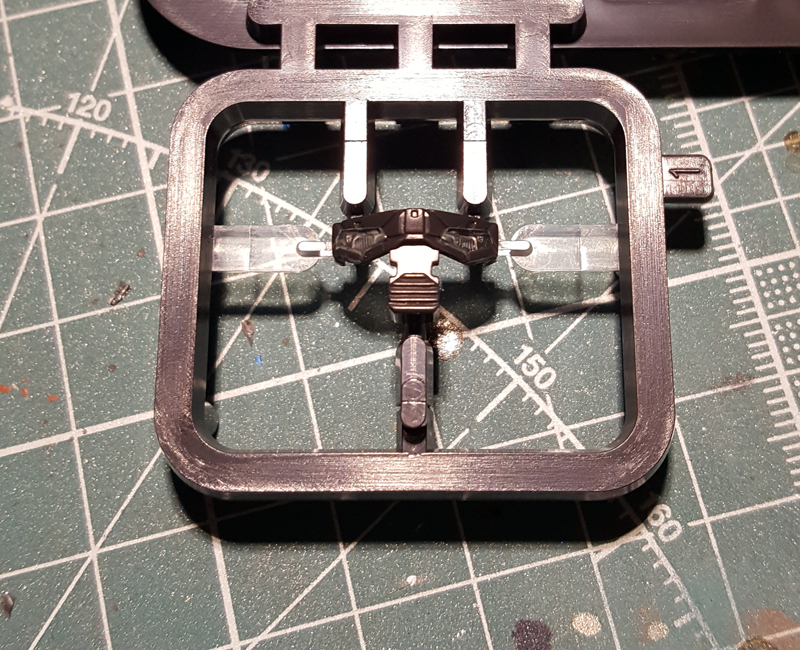
The first thing you’re likely to discover is that the eye piece is actually on the same sprue as the hands, and it comes pre-molded in grey and clear plastic. Since I always have a difficult time getting the eye stickers on straight, I thought this was a great idea for about ten seconds. Then I realized it’s just about impossible to paint the grey plastic here to match whatever I’m going to do with the inner frame.
Then there’s the assembly of the LED unit, which the instructions expect you to get right based on a picture that looks like it was photocopied in 1985. It also doesn’t work too well, to be honest. Maybe I assembled it wrong, but it seems to require a good bit of pressure on the battery to get the contacts to work, and even after bending them outward a bit, it still turns on and off randomly.
You assemble the inner parts of the head, and the LED unit fits right in there with its power switch sticking out the back. Sadly, the switch is covered up once you get the armor on, so you have to take that armor piece off to switch on the LED. It certainly looks better this way, though, and honestly, I don’t know how people really use these light-up gimmicks. You can’t leave the batteries in there anyway, they’ll leak and destroy the kit.
Note also that the vulcans are separate parts, which seems excessive given the lack of parts separation in the side skirts mentioned above, but I guess if you want to paint them a different color from the rest, it’s easy enough to do.
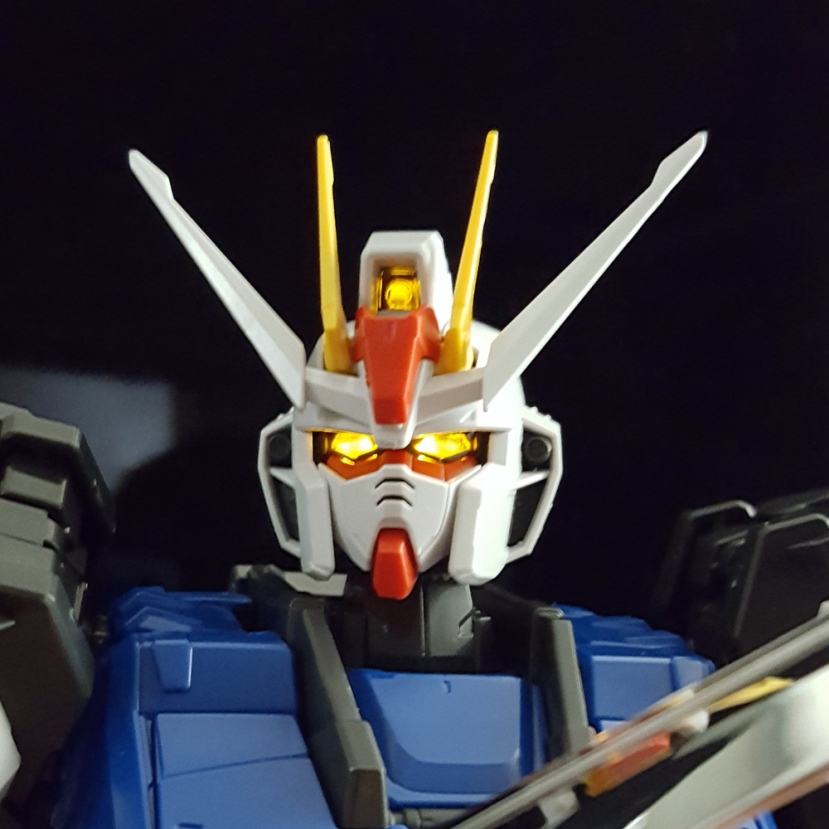
And here’s the head all done with the LED lit up. I must say, it’s a very nice-looking head. Tbe LED isn’t anywhere near as bright as the current units, but it does a decent enough job of lighting up both the eyes and the camera.
For some reason the instructions tell you to build the weapons at this point, which I didn’t do because I’m not crazy. Everyone knows the weapons are supposed to be the thing you realize you still need to do when you think you’re done. And why would I build weapons for a suit that doesn’t have arms? What madness is this? And why am I asking so many rhetorical questions?
So anyway, I skipped ahead to the shoulder armor. Nothing too complicated here – everything opens and moves, but the construction is fairly simple. You will have to glue those flaps on the front and back to their hinges, though, they don’t stay attached at all.
With the arms, I took the same route as with the legs and cut all the parts off the sprues before I started. They’re actually pretty complex as well, but as you can see, the parts count is considerably lower. I also had Kira Yamato stand there for the picture because this deep into a build, strange things amuse me. Note that the miniature stands up perfectly without a base.
The Kira miniature is actually really cool and I’m half thinking I might try to paint it. We’ll see. I do suck at miniature painting, so there’s that.

Assembly of the arms starts with the shoulder joints, which are also cube shaped.
Next is this hinge mechanism that goes inside the biceps and then attaches to the elbow. As you can probably guess, its purpose is to make the armor plates move out of the way to allow for more articulation, and as you should also be able to guess by now, this not only works beautifully, but also looks fantastic.
You then assemble the lower half of the arm, which is… jointed in the middle. With pistons. Not anatomically accurate if we’re looking for human anatomy, but it does allow the hands more room to maneuver than the stupid ball joints that every Gundam’s hands are mounted on, so it definitely helps, especially with some sword poses.
Here’s a look at the completed arms with and without armor, and at the elbow bend. I don’t know about you, but when the arm’s bent all the way, it looks to me like it’s been taken apart and reassembled. It’s so cool how everything on these limbs shifts and moves.
Next we have the hands. I don’t have much to say about them other than I’m still not, and never will be, a fan of fully articulated hands on Gunpla kits. The PG ones manage to look sort of okay because of their size, but even these have this weird gap between the palm and the first finger segment that just looks spindly and stupid. On the plus side, the Strike’s hand armor comes in two pieces, one of which moves slightly, and they’re different colors.
And yes, that is the hand gesture that you think it is.
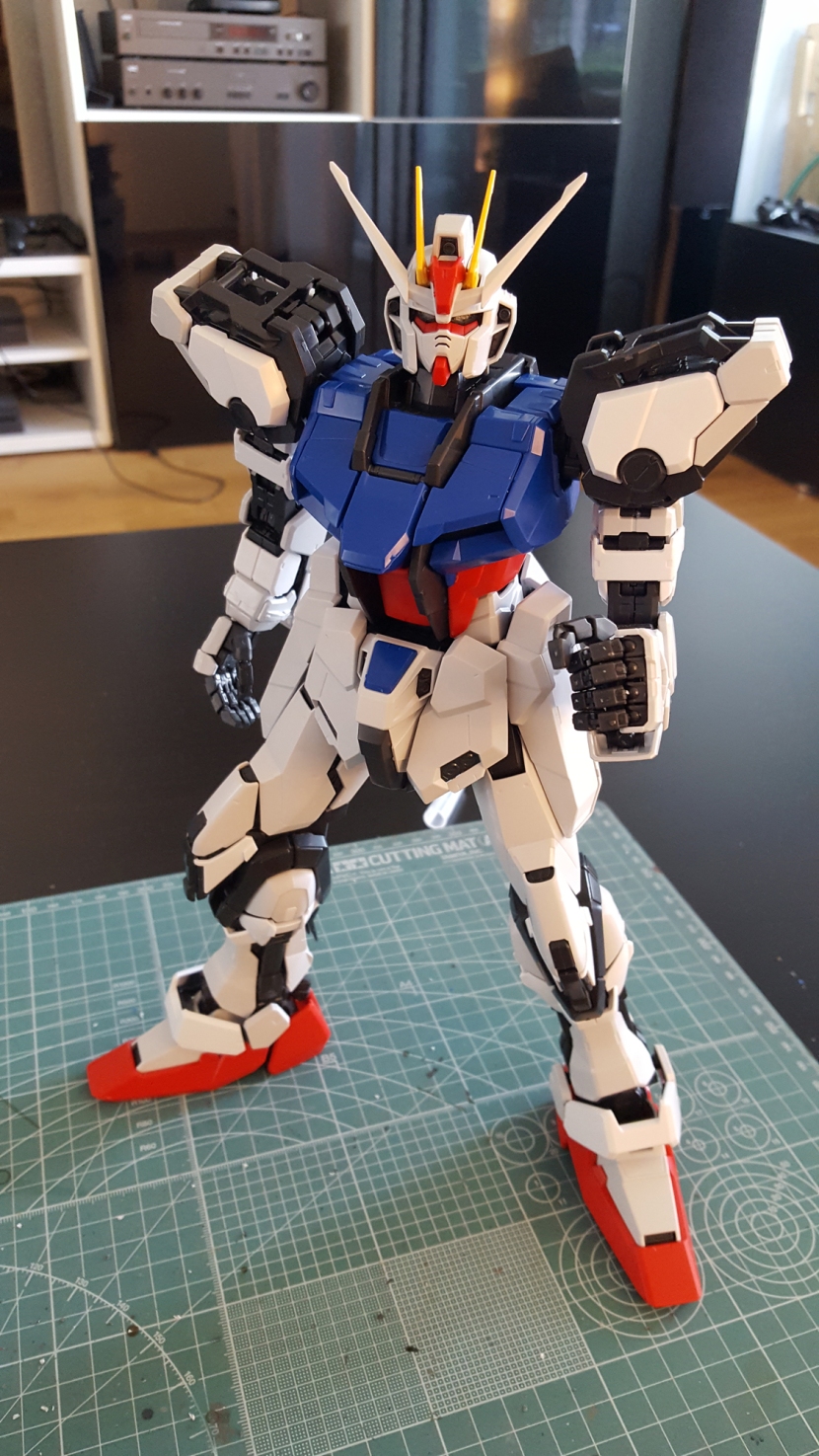
Here’s the Strike Gundam all snapped up, waiting for his weapons. Unlike with the MG RX 78-2, for some reason, I had no trouble at all getting a good picture of this guy. He looks great from just about any angle.
Anyway, on to the accessories. I was pretty dismayed when I started on the beam rifle because it seems to largely consist of just two halves that you snap together.
But then you realize that the additional outer casing parts actually cover up most of it, so there’s enough parts separation to make painting this in a reasonably interesting way easy enough, and most of the seamline gets covered up as well. It actually looks ok on the barrel, too, for some reason.
Fun tidbit: the trigger is a separate part. It doesn’t move. It’s just a separate part.
Also, there’s a little grenade in the launcher that you can take out. Take that, Sinanju.
Then there’s the Grand Slam sword, which only has the second dumbest name out of the accessories you get with this kit.
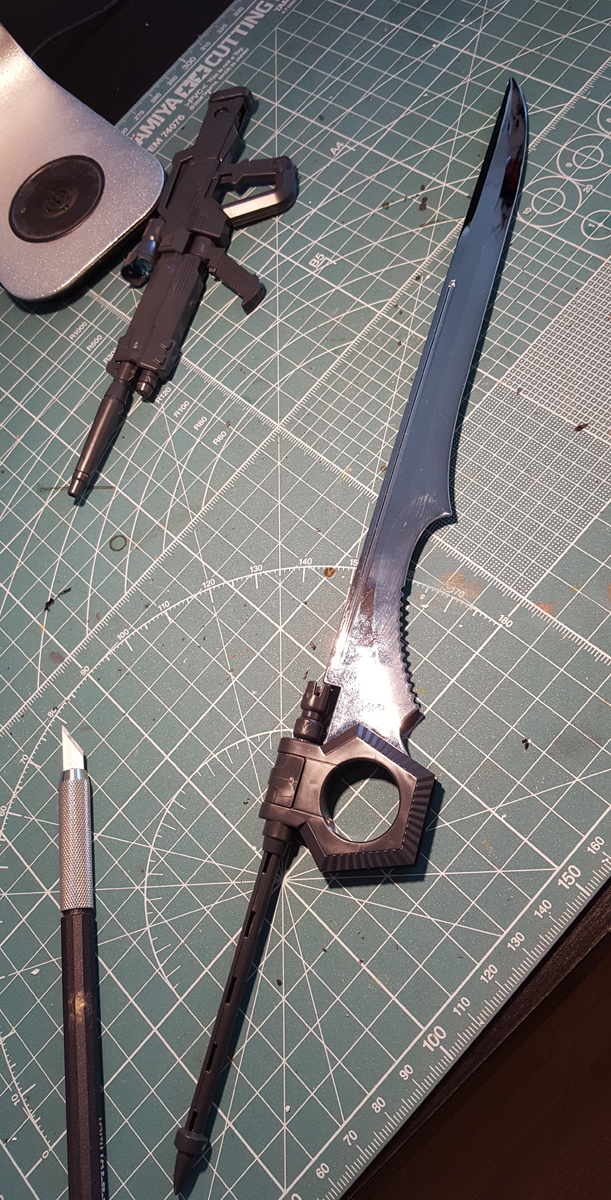
It’s absolutely gigantic, but honestly, I’m not a huge fan of this thing. The handle looks… well, like nothing, really, and while the coating on the blade certainly does what it’s supposed to do, it also means this thing’ll be a problem to paint if I want to do some weathering on it, for example. And the blade is slightly bent, probably as a result of the coating process.
I’ve just never been a real big fan of giant blades on mecha. I like swords and knives fine in other contexts, but why would the Strike Gundam swing around a surfboard blade the size of a house if beam sabers exist?
Speaking of blades, here are the “Armor-Schneiders”.
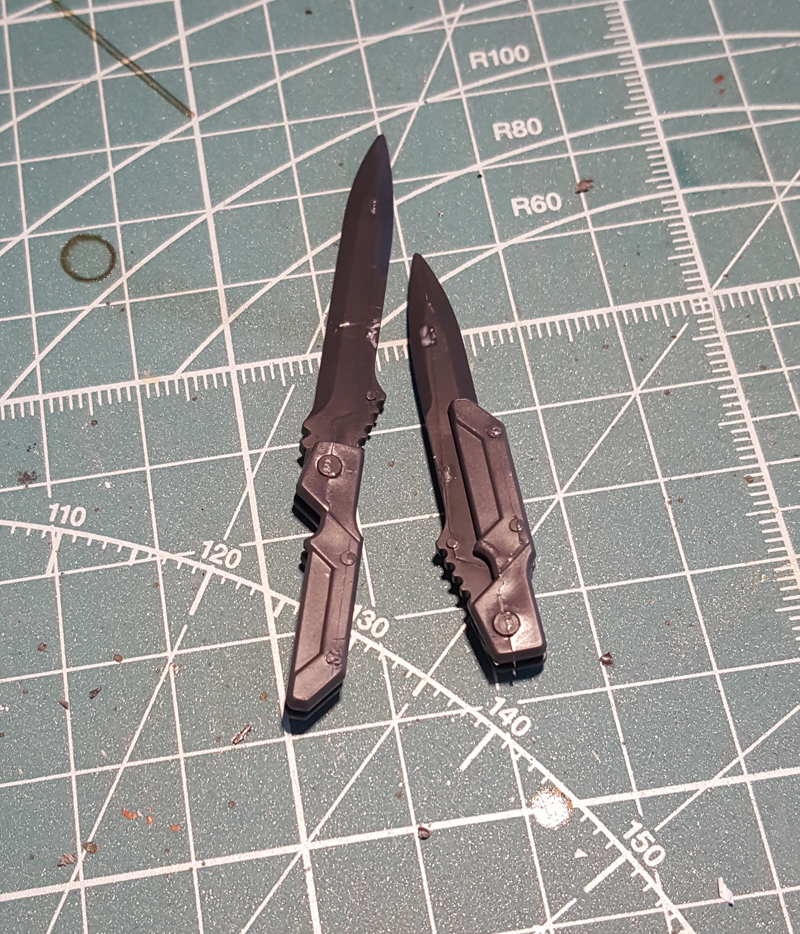
I can’t type that without snickering. See, German is my first language, and yeah, “Schneider” does translate to cutter, but it also means tailor, and like the English word, it’s a very common last name, and it just sounds like about the last thing you’d pick as a threatening, cool name for a knife. I’m sorry, but I guess my own language just doesn’t sound scary to me no matter how many bad WW2 movies I watch. Your mileage may vary.
A more objectively observable problem with these things is that they come pre-assembled on the sprue with the hands, which has zero benefits other than the fact that they’ll be a pain in the ass to paint and nub removal, as you can see, was a problem too. I don’t understand why this was done at all. Two parts for the handles, one for the blade, and they could’ve been on one of the grey sprues. I may just ignore these when I paint the kit, to be honest.
The shield goes together about how you’d expect. It has a little moving blast shield part for the slit, an attachment mechanism for the arm and a handle, plus some very nice red/yellow color separation. I really like that there’s a clear part in the slit – I’ll be doing some battle damage to that.
The attachment piece actually clicks into an opening mechanism on the back of the elbow, which works extremely well, and you can attach it either behind or on the side of the arm. It’s extremely well thought out, and because the suit also has similar contraptions on top of the shoulder armor, it doesn’t look out of place at all.
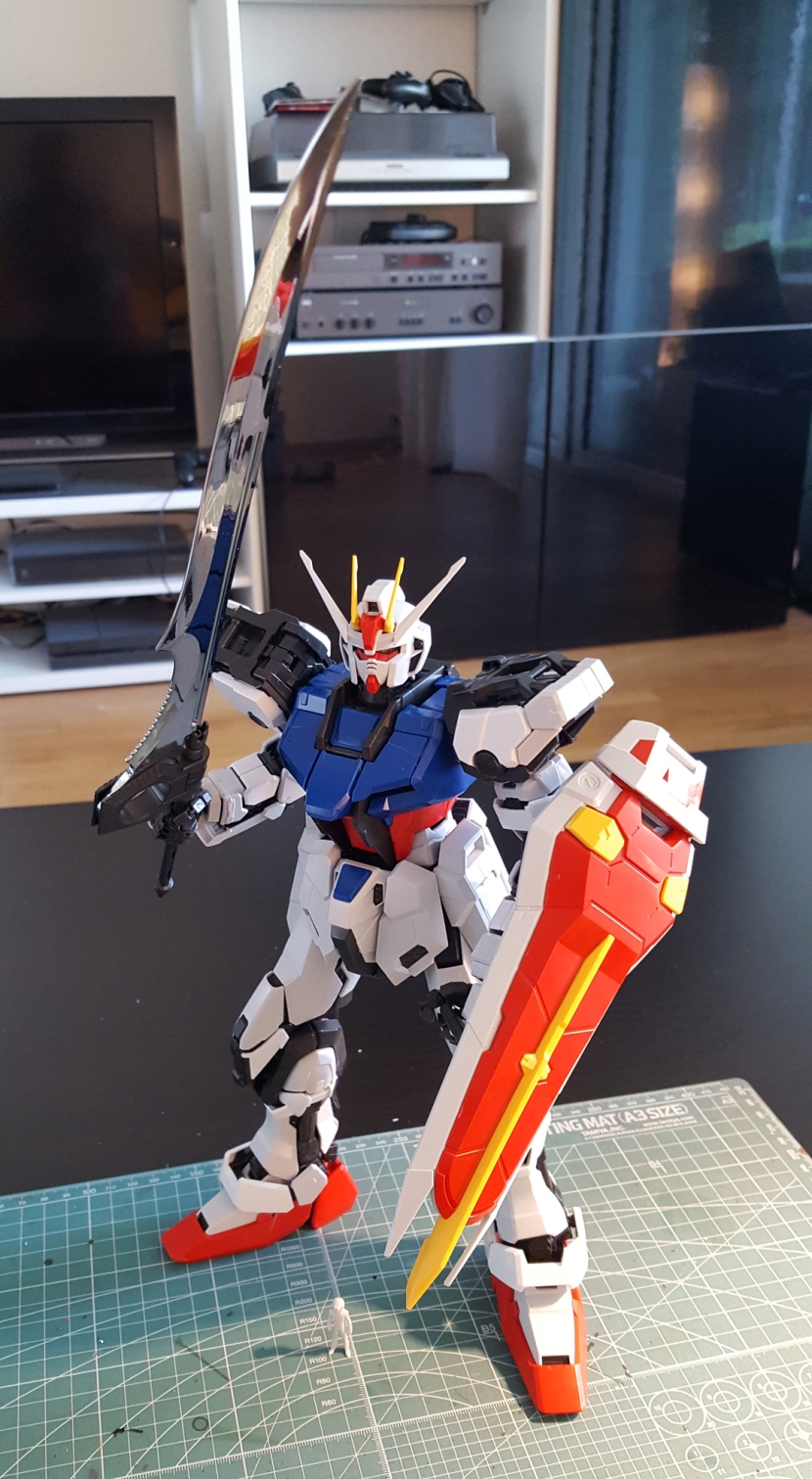
And we’re done. Yes, I posed him with the sword I just said I don’t like. What you can’t see here is that you can also attach the rifle to the… let’s say the belt, as with most Gundams. It attaches very firmly, and between that and storing the Armor *snicker* Schneiders in the side skirts, the Strike can actually carry all of its equipment. Would’ve been cool if there had been a way to mount the sword and/or the shield on the back, though.
Now I’ve complained about a few things here and there, but make no mistake, the verdict on this kit is a resounding “buy this fucking thing.” For a PG, it’s relatively cheap, and despite being well over a decade old at this point, the engineering holds up 100%. I can only imagine how this kit must’ve blown everyone’s minds back in 2004. It also really doesn’t look dated at all – there’s a very modern sleekness to the overall appearance of the kit. The MG FAZZ, for example, came out only a few years before, but the kits look like they’re a decade apart. I really came away from this build thinking this kit must’ve been way ahead of its time.
Where it does show its age is in some odd choices when it comes to parts/color separation and the occasional parts fit problem where it suddenly feels like a Kotobukiya kit. As of this writing, I haven’t tried to take apart the inner frame yet, but I know it’s going to take forever, and I very much fear I’ll break something. But then again, the parts fit isssues are really only in the torso – everything else is fantastic, and the legs in particular are incredibly fun to build.
And when it’s all put together, you have a version of the Strike Gundam that’s about as poseable as it’s beautiful. I keep staring at it and I can’t find a single square inch that I’d change. Everything about it looks great.
So that’s it for the snapfit. As I said at the top, I’ll probably do a more in-depth review of the kit in OOB condition with a pose photoshoot. It’s likely going to be a while until I paint it – I’m still waiting to get the Skygrasper kit, and I kind of want to see the Gundam with the Aile Striker attached before I finalize any decisions on color choices and weathering. Plus everytime I look at the damn thing, I want to play with it. Did I mention I really like this kit? Because I do. I really like this kit.

































































































































































